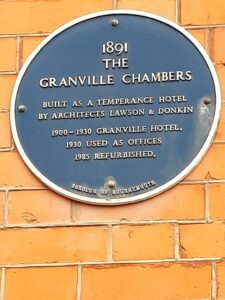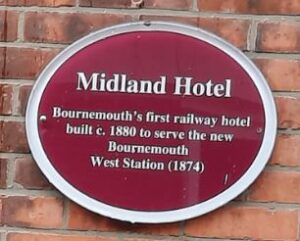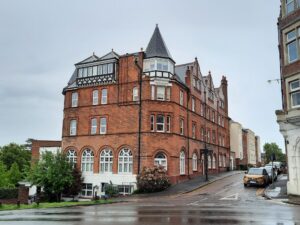All things temperance are never far from my mind, as my other half found out during our first weekend break away since the last Covid lockdown.
I feel very fortunate to look after the archives of the British Women’s Temperance Association (BWTA) here at the White Ribbon offices, and I always like to keep my eye out whenever I am out and about for anything temperance related.
An opportunity arose during a particularly wet day during our weekend away to Bournemouth recently. The weather wasn’t really an issue; we were very happy to see (and feel!) the sea again in all its glittering grey glory and even the weather couldn’t detract from the feeling that we were free to explore again after lockdown.
However, once the rain really set in we realised that we had a good few hours ahead, so with neither of us wanting to sit inside I had a little idea, and googled ‘Temperance Hotels Bournemouth’. Up popped a few links and images, and after a little encouragement my other half agreed to take me on a little driving tour to see what we could find. Did any of these buildings that were former Temperance Hotels still exist in the area?
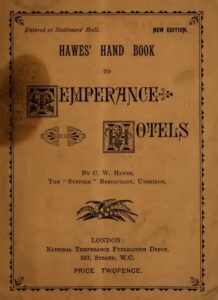 The first temperance hotel in Britain was opened in 1833 by Joseph Livesey, a key figure in the Temperance Movement. There were many such establishments across the country, providing the amenities of a hotel but without the alcohol. Directories were published listing these Temperance Hotels, where teetotallers could find suitable accommodation in an alcohol free environment, without the risk of temptation.
The first temperance hotel in Britain was opened in 1833 by Joseph Livesey, a key figure in the Temperance Movement. There were many such establishments across the country, providing the amenities of a hotel but without the alcohol. Directories were published listing these Temperance Hotels, where teetotallers could find suitable accommodation in an alcohol free environment, without the risk of temptation.
I had a few navigation issues finding the first building that still appeared to be in existence, but sat nav lady soon came to the rescue, much to my other half’s relief. It wouldn’t be good to fall out on holiday over my map reading skills or lack of!
“You have reached your destination”, and there it was….
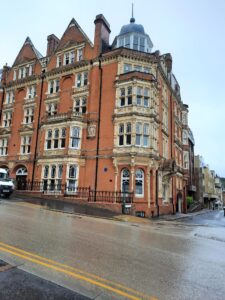 So this is The Granville Chambers, 21 Richmond Hill, Bournemouth. It is a Grade II listed building c1885[1], with mullioned and transomed windows and ornate sculptures.
So this is The Granville Chambers, 21 Richmond Hill, Bournemouth. It is a Grade II listed building c1885[1], with mullioned and transomed windows and ornate sculptures.
The blue plaque states ‘1891, The Granville Chambers, Built as a Temperance Hotel, by Architects Lawson and Donkin, 1900-1930 Granville Hotel, 1930 Used as Offices, 1985 Refurbished’. It now appears to be occupied as office space.
Having jumped out of the car to take some photo’s, it looked like the main entrance was originally around the corner on the side road. There is a large canopy under which is a window which looks like a half blocked up doorway, which was presumably the original entrance.
I love the grand architectural features of this building and wonder what original features if any remain on the interior? An internet search revealed that the same architects were responsible for other ornate buildings in Bournemouth including St Peters Church[2]
On to our next destination and having handed over my navigation skills to modern technology, we arrived without any detours this time!
This building is on the corner of Norwich Avenue and Queens Road and during its earlier years was the Midland Temperance Hotel[3]. It was situated very close to Bournemouth West Station, providing easy accessibility to alcohol free accommodation for those teetotallers travelling into Bournemouth by train for a holiday by the sea in the late 1800’s.
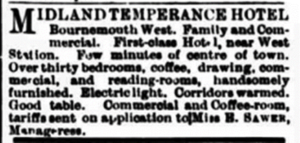 It is nowhere near as ornate as the architecture of The Granville Chambers building, but an advert from The Woman’s Signal in December 1894 that I uncovered on my return to the office confirms that it had ‘Electric light’, which must have been a real mod con! ‘Corridors warmed’…. did the promise of warm corridors also sway the teetotaller to pick this particular accommodation for their trip to the sometimes chilly British seaside?!
It is nowhere near as ornate as the architecture of The Granville Chambers building, but an advert from The Woman’s Signal in December 1894 that I uncovered on my return to the office confirms that it had ‘Electric light’, which must have been a real mod con! ‘Corridors warmed’…. did the promise of warm corridors also sway the teetotaller to pick this particular accommodation for their trip to the sometimes chilly British seaside?!
The Woman’s Signal was a periodical of the British Women’s Temperance Association whilst edited by Lady Henry Somerset, President of the British Women’s Temperance Association during the 1890’s. This publication often carried advertisements, so it would make sense that they would include one for temperance accommodation.
It had finally stopped raining on our little road trip, so we thought that we would head out of town as coffee and cake was calling by the sea, but another small detour meant we had to hold on just a bit longer for our latte’s!
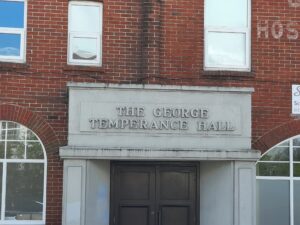 By chance as we were heading out along Holdenhurst Road, we almost went sailing past a small building with the words ‘The George Temperance Hall’ carved in the stone surround of the door. Of course I couldn’t let us drive past without a bit more investigation, so we pulled over to take a look.
By chance as we were heading out along Holdenhurst Road, we almost went sailing past a small building with the words ‘The George Temperance Hall’ carved in the stone surround of the door. Of course I couldn’t let us drive past without a bit more investigation, so we pulled over to take a look.
It looked like this former Temperance Hall was now a school for dance and drama, but when I came back to the office and did a bit more research, I found an early image[4] showing this building as The Massingberd Hotel which immediately caught my attention. The name Massingberd had cropped up in my work in connection with the history of the BWTA.
Looking back through some research from our periodicals, I found what I was looking for – an image of Mrs Massingberd in The Woman’s Herald of May 1893. She was a member of the Executive Committee of the BWTA and had a house in Bournemouth. The article has photographs and a short biography of each of the women of the Committee….
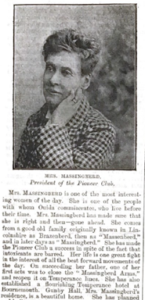 I love to find connections to the BWTA, so could the George Temperance Hall that was once The Massingberd Hotel, have been the Temperance Hotel described in the short biography about Mrs Massingberd from this article?
I love to find connections to the BWTA, so could the George Temperance Hall that was once The Massingberd Hotel, have been the Temperance Hotel described in the short biography about Mrs Massingberd from this article?
The short biography states that Mrs Massingberd had ‘established a flourishing Temperance hotel in Bournemouth.’ It seems too much of a coincidence not to be one and the same, but hopefully I might find some firm evidence for this during further work in our archives.
I had remembered this image of Mrs Massingberd because it struck me that this woman appeared to have her hair cut in a short modern style, quite unlike the usual style of the period. In fact Emily Massingberd nee Langton is described here as ‘independent and progressive’. She was President of the women’s Pioneer Club[5] which she founded 1892 and a member of the Women’s Liberal Federation[6].
I will definitely be looking more closely at Mrs Massingberd in the future. She was not only a member of the BWTA, but another forward thinking woman of the era.
My ‘To Do List’ seems to get longer with every new connection I come across. I am constantly finding more avenues to research in respect of the women of the BWTA. This is why I love my job; I started out looking at old buildings in Bournemouth but was able to find a link back to the hey day of the British Women’s Temperance Association and one of the women at the heart of the organisation.
All being well with no restrictions in place, we are off to Edinburgh soon. I know that the World Woman’s Christian Temperance Union (of which the BWTA was affiliated to) held a conference there in 1925, so I am already wondering how I might be able to squeeze in another little detour to see where this was held!
[1] https://historicengland.org.uk/listing/the-list/list-entry/1153491
[2]https://www.archiseek.com/tag/lawson-donkin/
[3] https://www.flickr.com/photos/alwyn_ladell/5511283915
[4] https://www.flickr.com/photos/alwyn_ladell/albums/72157627928294055/
[5] https://www.npg.org.uk/collections/search/group/1226/Pioneer%20Club
[6] https://liberalhistory.org.uk/history/womens-liberal-federation/

